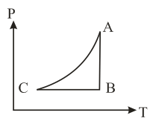Embibe Experts Solutions for Chapter: Thermodynamics, Exercise 2: Exercise-2
Embibe Experts Physics Solutions for Exercise - Embibe Experts Solutions for Chapter: Thermodynamics, Exercise 2: Exercise-2
Attempt the practice questions on Chapter 17: Thermodynamics, Exercise 2: Exercise-2 with hints and solutions to strengthen your understanding. Alpha Question Bank for Medical: Physics solutions are prepared by Experienced Embibe Experts.
Questions from Embibe Experts Solutions for Chapter: Thermodynamics, Exercise 2: Exercise-2 with Hints & Solutions
A monoatomic ideal gas, initially at temperature , is enclosed in a cylinder fitted with a frictionless piston. The gas is allowed to expand adiabatically to a temperature by releasing the piston suddenly. If and are the lengths of gas column before and after expansion, respectively, then is given by
An ideal gas undergoes a cyclic process as shown in the given diagram, where the process is adiabatic. The process is also represented by

If a diatomic gas is supplied heat in a process, it performs work What is molar heat capacity of the gas in this process.
Two samples of air and having same composition and initially at same temperature , pressure and volume are taken. and are made to undergo the following process:
Case and are compressed from volume to volume is compressed isothermally while is compressed adiabatically. The final pressure are and , respectively.
Case: and are allowed to undergo expansion from volume to volume . undergoes isothermal expansion while undergoes adiabatic expansion. The final pressures of and are and , respectively.
Which of the following processes is reversible
How much Uranium is required per day in a nuclear reactor of power capacity of .
